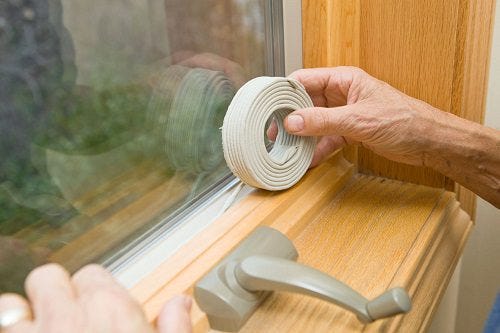4 of the Best Cost-Saving Ways to Heat Your Home This Winter
“Oh the weather outside is frightful, but the fire is so delightful…”
It’s a lovely classic holiday song, but it isn’t so lovely if you can’t afford your heating bills, and that’s assuming you’re fortunate enough to have a home to heat.
According to a new report from the U.S. Energy Information Administration, home heating costs are expected to go up this winter due to rising fuel prices. For nearly half of the U.S. households that use natural gas for heat, it will likely be a 30% increase on average, and those who warm their homes with electricity should expect to pay an average of 6% more.
Though this is tough news, try not to stress. Sometimes challenging circumstances can inspire us to find new ways of living…and saving money. Following the tips below can help you heat your home and offset some of winter’s costly bite!
4 of the Best Cost-Saving Ways to Heat Your Home This Winter
Sealing gaps around doors and windows can make your home feel warmer – and save you 5 to 10 percent on your energy bills.
- If you don’t already have door sweeps, consider getting some. (You probably need them if you can see light at the bottom of the door or can feel cold air coming through the door.) Door sweeps are flat pieces of plastic, aluminum, or stainless steel fitted with a strip of nylon, plastic, or vinyl, or a sponge brush to fill the space between door and threshold.
- If you haven’t weather stripped your house, get some tension seal (usually plastic or metal), foam tape, or felt weather strip and get to work. You’ll find many options at most local and big box hardware stores.
- When it comes to window caulking, it generally needs to be redone every five years, and sometimes sooner. Check to see if you need to re-caulk.
- If it hasn’t been done already, consider adding insulation to your attic, crawl spaces, and/or basement rim joists. The insulation is especially important in colder climates. (And don’t forget you can insulate your hot water heater as well, which can allow you to turn its thermostat down to provide a bit of cost savings!)
- Warm Up Your Rooms
Go from room to room in your home to evaluate what you can do to increase heat and reduce costs.
- Start with the drapes. Drawn draperies can reduce heat loss from a warm room up to 10%. Invest in double or triple layer draperies to keep the warmth in. Keep them closed during the day, unless it’s a room that gets a good amount of sunlight. In that case, open them to let the sunshine heat the room.
- Add throw rugs to rooms with bare flooring.
- Consider using a humidifier. Humidity makes indoor air feel warmer, and you can probably keep your thermostat lower. It will help counter the drying effect of heated air, too.
- Make sure your fireplace’s flue damper is tightly closed when not in use. This will keep heat from escaping, and cold air from getting in.
- Move any furniture that blocks heat coming from a vent or radiator.
- In the kitchen, remember to keep your oven door open after you bake to make use of that heat!
- Though it might seem counterintuitive, consider reversing your ceiling fans. This can help push the warm air that rises toward the ceiling back down toward floor level.
- Instead of heating the entire house, use a space heater in whatever room you’re in. You can designate a particular room for most of your family activities and warm that room only. Convection heaters and radiant heaters are the most popular and efficient.
- Make sure you have warm throw blankets to use in each room.
- Set your thermostat to 68°F while you’re awake, and between 60-65°F when you go to sleep at night for cost savings.
- Warm Up Yourself
Don’t forget to warm yourself up too!
- Layer yourself with a sweater or sweatshirt over a t-shirt, slip on some socks and slippers, add a scarf or gator, and maybe a warm beanie too, if needed. Consider fingerless gloves if you have cold hands. Wear whatever it takes to maintain comfort.
- Invest in some heat warmers or hot water bottles for warmth while you work, relax on the couch, or in your bed when you sleep.
- Exercise regularly and/or get up and do some activities while you’re at home. Moving around will help warm you up.
- Don’t forget to warm up on the inside, too. Drink tea and eat hearty soups. Add warming foods that increase your blood circulation.
- Warm Up Your Bed
Just like you layer your clothes, layer your bed!
- Start with soft flannel sheets – a double napped flannel sheet is perfect.
- If you’re in a particularly cold climate, add a warm but thin blanket or quilt on top of your flannel sheet, then add a sheet on top of the blanket or quilt for an extra layer of insulation.
- Top it off with a duvet cover. The warmth of a duvet is rated by a universal unit known as a tog. It’s a measure of the duvet’s ability to trap warm air. A tog of 13.5 or higher is considered suitable for the winter months.
- If you really want to turn on the heat, get a heated mattress pad!
- Don’t forget to snuggle up to your partner for that body heat.
Implementing these tips can help you enjoy the cost-savings and extra warmth this winter!
At BrainMD, we’re dedicated to providing the highest purity nutrients to improve your physical health and overall well-being. For more information about our full list of brain healthy supplements, please visit us at BrainMD.
- Here Are Some of the Best Tension Release Exercises to Help You Feel Your Best! - April 17, 2024
- Foodscaping: How to Grow Healthy Foods In Your Own Garden! - April 12, 2024
- Eat Your Fruits and Veggies (Don’t Drink Them) - March 29, 2024





Thank you so much for the information my dear lady.